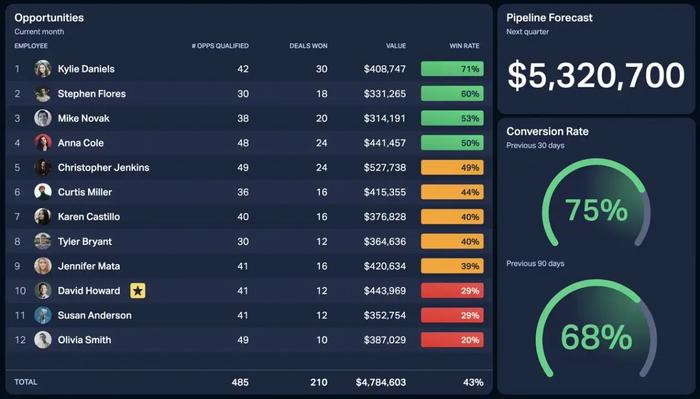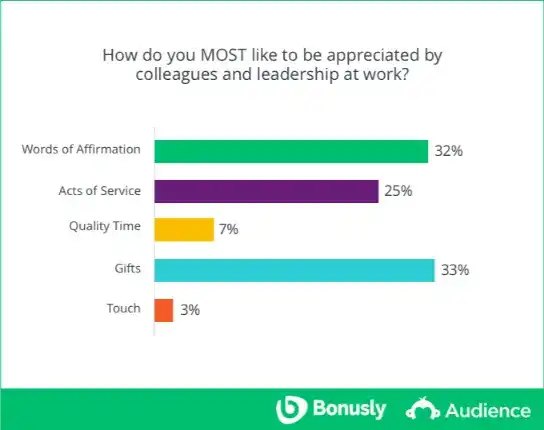Sales representatives tend to thrive in competitive environments — but there’s a fine line between healthy and unhealthy competition. Introducing a sales leaderboard into your sales department can gamify sales activities and encourage the kind of friendly, constructive competition that amplifies team productivity.
But what is a leaderboard in sales, and how can you implement one in your office? Let’s get into it.
What are sales leaderboards?
A sales leaderboard is a visual tool sales departments use to track team performance against business goals. More specifically, it acts as a visual representation of your sales reps’ performance, placing individual performance KPIs side by side in a ranking-based system.
Sales leaderboards have become popular as a means of motivating reps and building high-performing sales teams. They gamify work activities with point-scoring and rewards, driving healthy competition and increasing engagement by recognizing top performers.
So, how does a leaderboard work?
A sales leaderboard is similar to a bowling scorecard (or a scorecard for any individual sport). But instead of tracking the number of pins every player has knocked down, a sales leaderboard tracks sales performance metrics, such as revenue generated, quotas attained, calls made, etc. They can be created using apps like Ambition or Plecto, or via your sales CRM.
Benefits of sales leaderboards on team productivity
What are the benefits of leaderboards, and how do they drive team productivity?
Encourages healthy competition and innovation
Almost 80% of employees say that healthy competition benefits their performance. Sales leaderboards gamify work activities and fuel friendly competition between colleagues. Reps can compete in fun games and contests, such as who can generate the most qualified leads in a week, motivating engagement and driving better results.

Image sourced from Resumelab.com
Fosters transparency and accountability
Leaderboards allow sales reps to see exactly how they’re performing at any given time, holding them immediately accountable for their performance. Those near the bottom of the leaderboard are encouraged to do better, while those at the top are motivated to work hard to maintain their prime position.
Boosts morale and team engagement
Healthy competition fuels team engagement. Nobody wants to miss out on the fun, and they certainly don’t want to be at the bottom of the leaderboard. So, your sales reps are likely to get into the spirit and encourage each other to take part.
Plus, an individual win is a win for your whole team if you make it so. By offering rewards that include your entire team, you can use sales leaderboards to boost team morale. For example, one of your rewards could be an expense-paid-for team meal, where the employee at the top of the leaderboard gets to pick the restaurant.
Improves communication and collaboration
As well as visually communicating strengths and weaknesses, sales leaderboards can spark constructive face-to-face conversations and competition, leading to better collaboration. Through gamification, colleagues can get to know each other on a fun, personal level, aiding long-term communication and resulting in better problem-solving, brainstorming, and teamwork.
Enhances coaching and development
Sales leaderboards amplify coaching and development by increasing your visibility into the strengths and weaknesses of individuals. With a glance, sales managers can identify middle-of-the-pack employees who, with a bit of coaching in a specific area, have the potential to soar to the top of the leaderboard.
Similarly, sales managers can identify poor performers and provide them with additional coaching or support.
Best practices for implementing sales leaderboards
Think you want to incorporate sales leaderboards into your office? Here are some best practices to help you do it.
Allocate resources for training materials and platforms
As we mentioned earlier, you’ll need to source a sales leaderboard tool that meets your needs. Integrating the tool with your CRM — for example, integrating Plecto with Capsule CRM, provides access to real-time sales performance data and leaderboards, right inside your CRM.

Image sourced from Plecto.com
But those aren’t the only tools you’ll need. Bear in mind that your new sales reps will be up against seasoned employees. To empower newer sales reps to hone their skills and climb up leaderboards, it’s a good idea to invest in training materials.
Allocate resources for training materials that cover vital sales strategies, such as social selling, relationship-building, and qualifying leads. Additionally, use career development software to conduct learning needs assessments that identify individual strengths and weaknesses. When sales reps know exactly where to focus their training, it can drive them toward achieving specific, achievable, measurable goals.
Establish a realistic budget to reward top performers
The rewards that your reps receive for meeting their goals tend to be the biggest motivator for engagement. So, you want to offer rewards that your sales reps genuinely care about.
It won’t surprise you to know that gifts are favored by many (33%) in the workforce. Employees want monetary recognition for their hard work, whether it be a gift voucher, a paid meal, tickets to an event, or simply cold hard cash. So, you’ll need to establish a budget to guarantee that whatever rewards you offer are financially viable for your company.

Image sourced from Bonusly.com
The type of rewards you choose will have much to do with how often you reward employees. Are sales leaderboard achievements celebrated weekly? Monthly? Quarterly? Is there an extravagant prize at the end of the year? Whatever you decide, utilize accounting and cash flow management software to make sure that the rewards are within your budget.
Set achievable role-specific metrics and targets
Avoid creating a singular sales leaderboard that exclusively celebrates the reps with the biggest selling numbers. While rewarding your top ten sellers is important — and will definitely motivate your best performers — you risk disengaging the rest of your team.
For new, younger, or less confident sales reps, generating the huge numbers racked up by your seasoned sellers will feel unachievable and intimidating. And remember, the whole point of sales leaderboards is to motivate your team to succeed — not for members to feel inferior.
The solution? Create a range of leaderboards for specific roles, metrics, and targets. For example, you could create leaderboards that reward:
- The number of high-quality leads generated.
- The best personalized emails.
- The volume of meetings booked.
- The fastest lead response times.
- The employees with the best customer satisfaction scores.
By setting role-specific metrics that are achievable for everyone — and don’t focus exclusively on revenue generation — you give newer and middle performers a chance to shine. Measure behavioral KPIs and skills outside of hard selling to demonstrate that every team member is a valuable asset to your business.
Balance individual performance with team goals
Sales leaderboards are great for fostering healthy competition between sales reps — but only if you implement them in the right way.
If your sales leaderboards focus too much on individual performance, you risk hurting team dynamics and creating a workplace culture that is driven by personal success. However, this can be easily rectified by balancing individual performance with team goals.
Aim to foster a culture in which an individual win is a team win. Include the entire team in the celebration when an individual goal is met and encourage team members to support others to reach milestones and targets.

Provide timely and accurate feedback
How are sales reps meant to climb up the leaderboard if they don’t know why they’re at the bottom?
Sales leaderboards can give you a good idea of who is struggling to meet targets. By approaching struggling sales reps and delivering timely, accurate feedback, you empower them to make quick improvements that can change the trajectory of their leaderboard position.
Remember, syncing your online CRM to your sales leaderboard enables you to access your sales performance data in real-time. With the ability to view the most up-to-date metrics, team members and sales leaders alike can accurately gauge performance.
Measure financial impacts and leaderboard ROI
The purpose of a sales leaderboard strategy is to increase sales productivity and employee performance through gamification. Which, in theory, should generate more revenue for your business. But does it?
To determine the financial impact and ROI of your sales leaderboard strategy, you’ll need to conduct an in-depth analysis of key sales metrics and employee performance KPIs.
The exact data you’ll need will depend on your specific business goals. Here are some examples of what you might measure:
- Total revenue
- Lead to opportunity conversion rates
- Average contract value
- Win rate
- Quota attainment
- Productivity metrics, such as calls made or emails sent

You can access these metrics via various sources: your sales management software, your CRM system, your HR software, etc. Online HR management software will present you with a full view of employee productivity. Alongside attendance and absence stats, you can track employee performance gains since the implementation of your leaderboards with intuitive reports.
Final thoughts
One of the best things about sales leaderboards is their ability to incite healthy competition in the workplace. They take the competitive spirit that lives in the sales environment and complement it with gamification. This not only improves individual performance but amplifies team communication, collaboration, morale, and productivity.
So, why not create your first sales leaderboard today? Make sure to communicate the goals and objectives of your leaderboard to your sales reps — and don’t forget to offer some enticing rewards.

![Automate contact creation in Capsule from LinkedIn leads [With Magical]](https://cdn.sanity.io/images/poftgen7/production/142b6351ab8fc46e6af8f2a3fd4155042daf24eb-1200x628.png?w=300&h=157&q=75&fit=max&auto=format)


